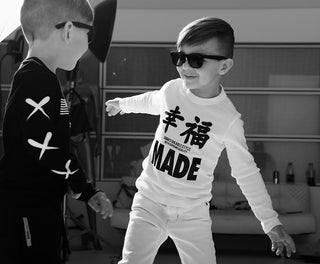“We’re the rap music of children’s fashion,” states MADE Kids designer Louie Esquibel. Bearing the weight of infinite doubters, this three-man Miami-based operation has grown leaps and bounds since its inception a year ago, gaining steady attention from the Internet and capturing the hearts of fashionistos left and right at last season’s trade shows – an uphill climb which was initially met with skepticism, but has since become the first children’s brand to show at Agenda.
I stumbled across MADE Kids a few months back while browsing through my daily newsfeed. As a parent myself, I can understand why folks live vicariously through their children, especially when it comes to kicks and clothes, but as a money-conscious father, I’ve also learned that kids are easily pleased with cartoon characters tees and don’t particularly like wearing leather jogging pants.
Curious about the market for kids streetwear and the inspiration behind creating higher-priced garments that’ll, for the most part, become obsolete in a few weeks time, I caught up with Andrew Guzman, Pedro Tuma, and Louie Esquibel – the trio behind this burgeoning apparel company – to get an inside perspective into three motivated individuals that take their business seriously, yet understand the complexities of the market.
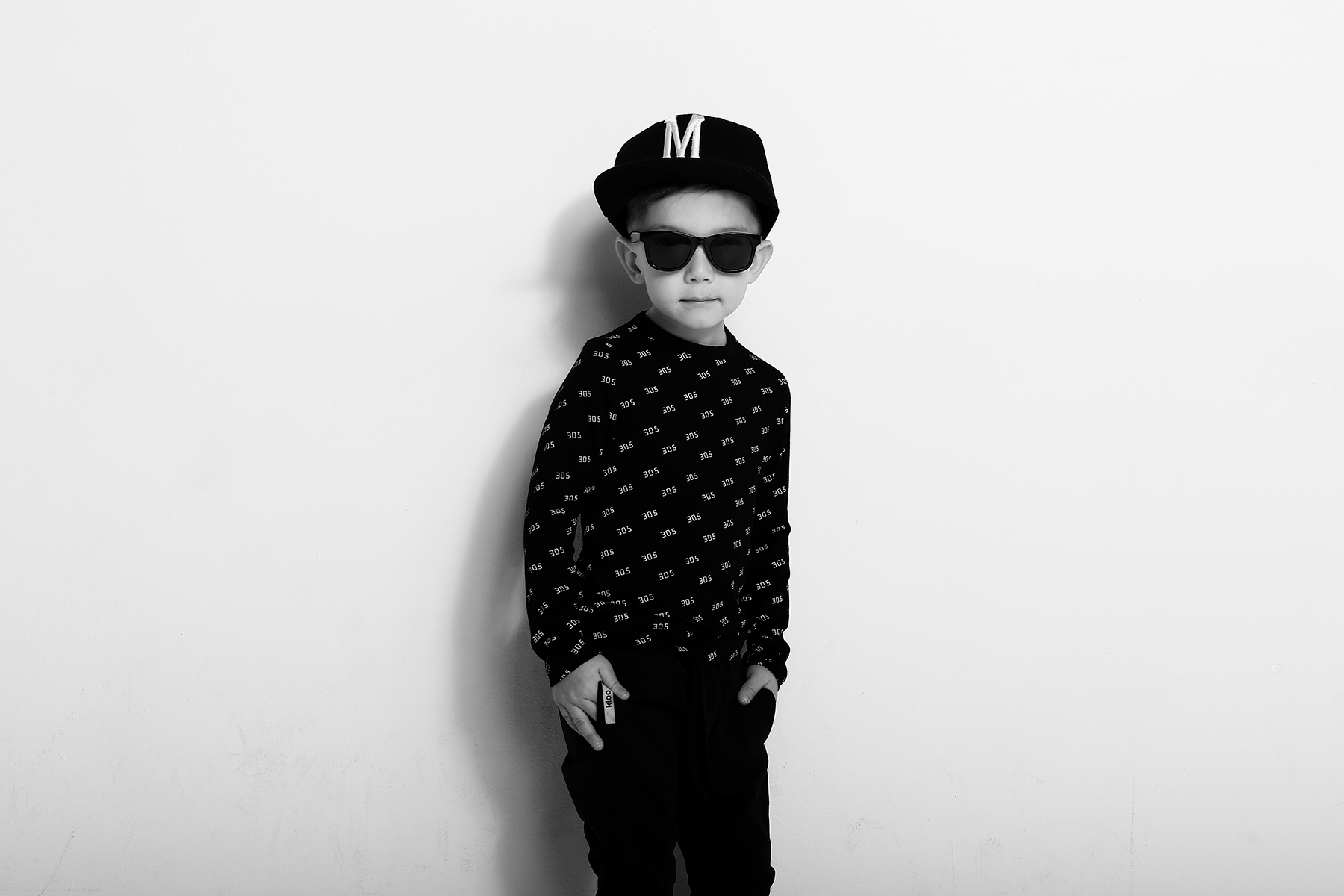
LUIS RUANO: Is there a reason why you guys only go up to a size 10, rather than all the way through a 16?
PEDRO TUMA: Andrew and I had this discussion with a guy that we met with yesterday, who has an 11 year-old son. The kid only wants to wear Armani.
ANDREW GUZMAN: We had a great meeting with the guy, so after we were like, “Oh, we see you have a kid. You want anything? Let us know and we’ll hook you up.” “No, no my son is 11 years old and all he wants to wear is name brand stuff. True Religion jeans and Armani.”
Pedro: We feel like when kids get to a certain age, when they’re about in middle school, they want to be in high school. They want to be wearing the older kids’ clothes because they can kind of fit into them. What we’re doing is for the parents who want their kids to look dope [before they get to that age].
Andrew: I remember being 13 – I didn’t want to be 13 and wearing what a 4 year-old was wearing. That was my reasoning why we didn’t want to jump into that [11+] age range.
I hear you guys are getting into cut-and-sew as well?
Andrew: The main reason why we wanted to do this – obviously we want to make money because you have to survive – but it wasn’t for the money. It was to literally have an impactful change in the culture [of streetwear].
I personally feel that we were amongst the first doing this and that it’s my job to make sure we push it. Now, if you look at the current state of the kids’ market, especially with Instagram, there are 20 or 30 lines that are doing kids’ streetwear. And they kind of have our essence, if that makes any sense?
AN ADULT WILL WANT IT, BUT IT MAKES SENSE FOR A KID
Even the bigger lines are getting grittier now, so the whole paradigm is changing. I feel that we have to take it up a notch because there’s so much more we could do. I’m not talking about just regular cuts, I’m talking about infusing the best that we can – our formula is: An adult will want it, but it makes sense for a kid. It’s just taking that [next step] forward. The best logical progression.
Pedro: When it comes to cut-and-sew, as far as building a brand, I’ve always been scared of that part, because it either makes you or breaks you. The cost of cut-and-sew is so high that if you don’t come correct, or if your consumer isn’t ready for it, you’ve invested all this money and now you have product just sitting there.
I think we’ve planned it out well. Our consumer and fan base is ready for it. We like to cross all of our t’s and dot all of our i’s, which is the reason why we’re in LA now; to have all that set up so when we’re ready to go into production and we’re ready to get into cut-and-sew, everything’s set up. We’re all about quality. It’s not like we just want to get any type of cotton, put it together, and make our own custom tee. No, we want the best cotton available.
Andrew: We’re making sure that it’s the best cotton blend. We’re making sure that the shrinkage is factored in, we’re making sure that the sewing is on point, we’re making sure the cutting is on point, and we’re going into the gritty details on these.
Louie: I’ve been swatching for a while already. I’m spending hours in fabric stores or in one particular American Rag, just swatching. To me, cut-and-sew is a huge deal. Once you start doing cut-and-sew, it sets you apart, clearly. That’s what I’m hoping to contribute – different cuts, so cool that an adult would wear them.
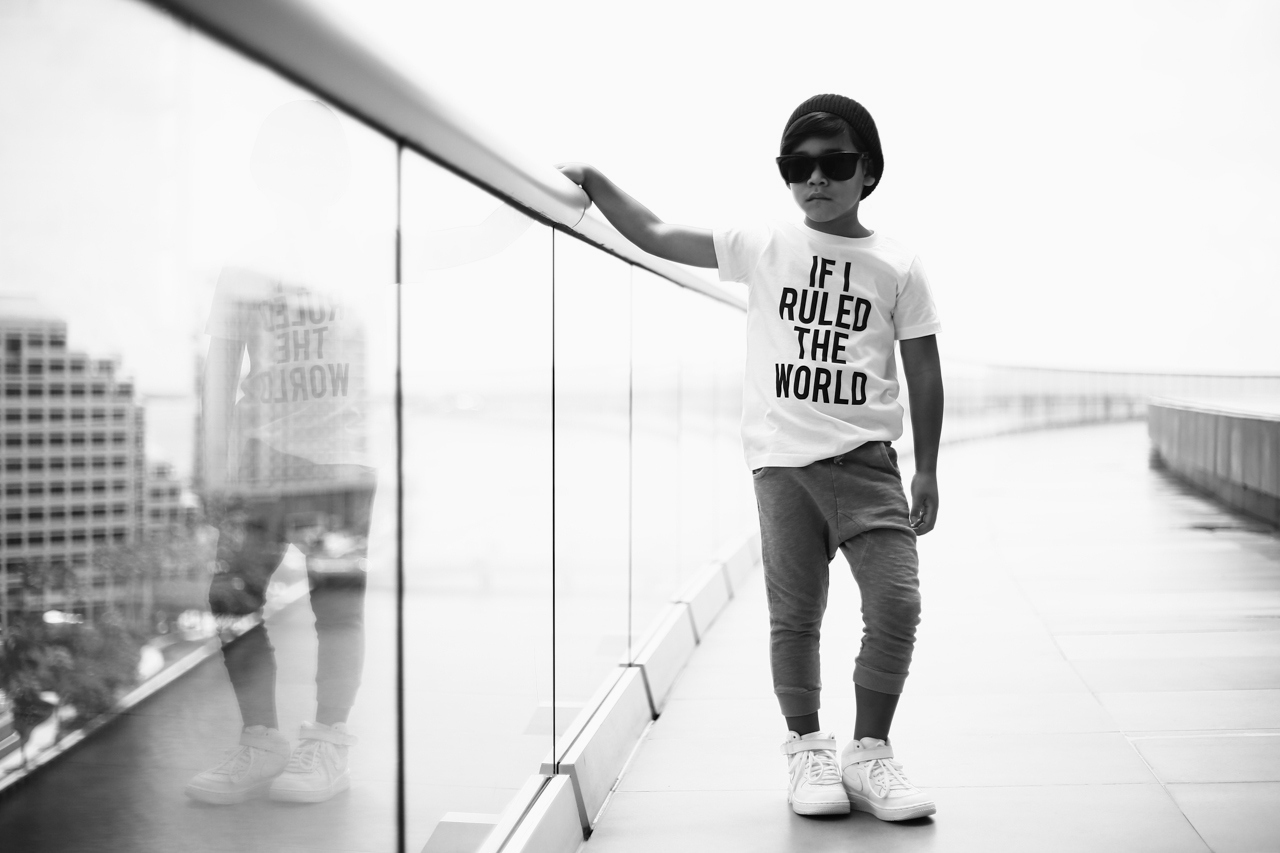
Kids outgrow clothes quickly, what do you say to the parents that ask why they should spend more money on MADE Kids instead of getting something comparable at a department store?
Pedro: There are certain things that my wife won’t buy for our daughter because of what it costs and how long she’s going to wear it for. But then there’s other things that we like so much that it’s like, “We gotta have it.” And I think we’re creating that “we gotta have it” piece. That’s what we’re striving to do. Everything we put out it’s like, “We gotta have it.”
Andrew: It’s all about how it makes you feel. In other words, the whole point of the line is that when you first see it, you feel something, it hits you; it gives you an emotion. And technically, that’s the same emotion that I want when a parent buys the shirt. At the end of the day, I made this clothing line not for every day wear, but for when you take your kid to see grandma and he looks like the dopest kid in the household.
When he goes out for a birthday party, he’s the dopest kid hanging out. That’s what I made it for, for the parents to be like, “Yo, this is my son!” [Laughs]
THE MOM FROM OHIO IS GOING TO LIKE IT FOR HER KID, TOO
Louie: One thing I can say, not to brag before it’s even out, but the cut-and-sew that’s being developed, I promise you, can stand next to any adult brand. I’m taking inspiration – we’re all inspired from fashion, inspired from straight runway. That’s what I study, that’s what I love, and that’s what I’m bringing into that. The luxurious, runway, weird cuts, but not too weird.
Ultimately it seems like your target audience is parents, more than children.
Pedro: We do kids clothes, but our target market is the parents. We’re selling to the parent, it’s the parent that’s going to make the decision if they like it or not.
Andrew: The trade shows are the best example of that. If you’ve seen all the people coming in to the trade shows freaking out, it was all the parents that were dressed up themselves. But they were all stylish people that saw the shirt and were like, “What?” And they’d just run with it.
Pedro: We could want it to be for the stylish parent or the parent who’s fashion conscious, but at the end of the day, what I’ve seen and what I’ve gathered with the brand is that the mom from Ohio is going to like it for her kid, too. Our vision from the beginning was to create a brand for kids that’s accepted by everyone, from streetwear to the stay-at-home mom in the Midwest. There’s a lot of culture behind what we do, and it attracts people that admire the culture.
Can you talk a bit about timing in fashion?
Pedro: A lot of things in life are about timing; coming out at the right time. And I think for some reason, right now it’s the right time for kids. And the reason I say that – it’s weird – the emails that we get, the response that we’ve been getting, the collaborations that we’re working on. Everyone wants a piece of this right now and it wasn’t like this when we first started. It’s been probably this year where it’s like, “Okay, it’s being accepted by a lot more people.”
Even at Agenda. Agenda would give us a headache, they didn’t want kids in there, they don’t want us to be a part of it and then something happened where they were like, “We’ll let you show at Long Beach. Okay we’ll let you in New York.” And then finally, “Vegas.” That’s just a small example, but it’s an example of kid’s apparel being accepted. We can literally pave the way for this kids’ market [in streetwear].
Louie: I think one thing that hasn’t been mentioned is the videos and the lookbooks. To me, that’s so key and I think we nailed it with that. Showing the customer how it’s worn, how it looks. There’s real design and real love. We’re not just throwing graphics together and seeing what comes out of it. There’s actually research behind [what we do].
Andrew: When you see our stuff you feel something. You either love it or hate it, but you feel something. That’s the key – that’s the main thing we talk about – does it make you feel something? That’s the foundation of what we do.
What’s something that’s overlooked when it comes to MADE Kids?
Andrew: Honestly, I think it’s the attention to detail that we put into everything. We really care, we get the fact that in the kids’ market there are nuances that we don’t have with an adult market. Like for kids you have to have – the print has to be certain quality because the kids will get sick by it. The standard stuff we’ve covered. But the attention to detail that we go into to making sure that the thing fits right. Making sure that everything we put out is merchandised the right way. The thought we put behind everything is extensive.
We make a simple shirt [that says] “If I ruled the world,” but it wasn’t like whoa, we’re bumping to music and then it’s just there. No, we make sure that that shirt is merchandisable.
WE ACTUALLY GIVE A FUCK
We care about the smallest things – [like] shrinkage. For me, I hate shrinkage. I’m working right now to make that shit go away. In the kids’ market, that’s very prevalent, you get a size 5 T-shirt, you wash it one time, and it goes down a size. For a parent, that’s really frustrating. I want to make sure that our garments last long. I want these shirts to be hand-me-down shirts. They don’t shrink, they don’t break apart, all that is construction, all that is fabrics and I don’t think people get that.
Streetwear consists of: You get a blank, hit it, and go on with your day. I think that’s what people think we’re trying to get away with, but it’s more than that. We actually give a fuck.
Louie: That’s what made me want to be on board more than anything. When I spoke with Andrew and he said that, I was like – he actually cared about blank shirts, which was rare to me. He was like, “Can we go fabric swatch for shirts?” And I was like, “T-shirts? You’re not just telling me to go to Ellie’s and buy a box?” “No. I want to fabric swatch and I want you to pick the dopest fabrics you can find.” I was just like, “Wow, this is it, I’m on board with this.” Because that’s so rare dude, especially with a lot of companies now. When you’re up and coming, the first thing that you do is buy the cheapest stuff.
Pedro: I think that’s part of my job. From the beginning our first meeting was, “I don’t want to be a part of something where we cut corners. You have to understand that this is going to take time, and with time comes money.” There’s this whole process to building a brand. And supposedly, like he said, everyone wants to start a brand. They think that they can just get away with buying the cheapest blank out there, going to the cheapest screen printer, and saying, “Let’s sell it for $40 bucks.”
When it comes down to it, we want to be known for our quality, we want to be known for the attention to detail, we want to be known for the trend research and the design research that goes behind it. As simple as the brand looks, with its one-color hits, there’s a lot more that goes into it than just sitting in front of a computer and typing words. People might say, “Oh, it’s black and white, that’s super simple.” But no, there’s so much more behind it because of the passion we put into it.
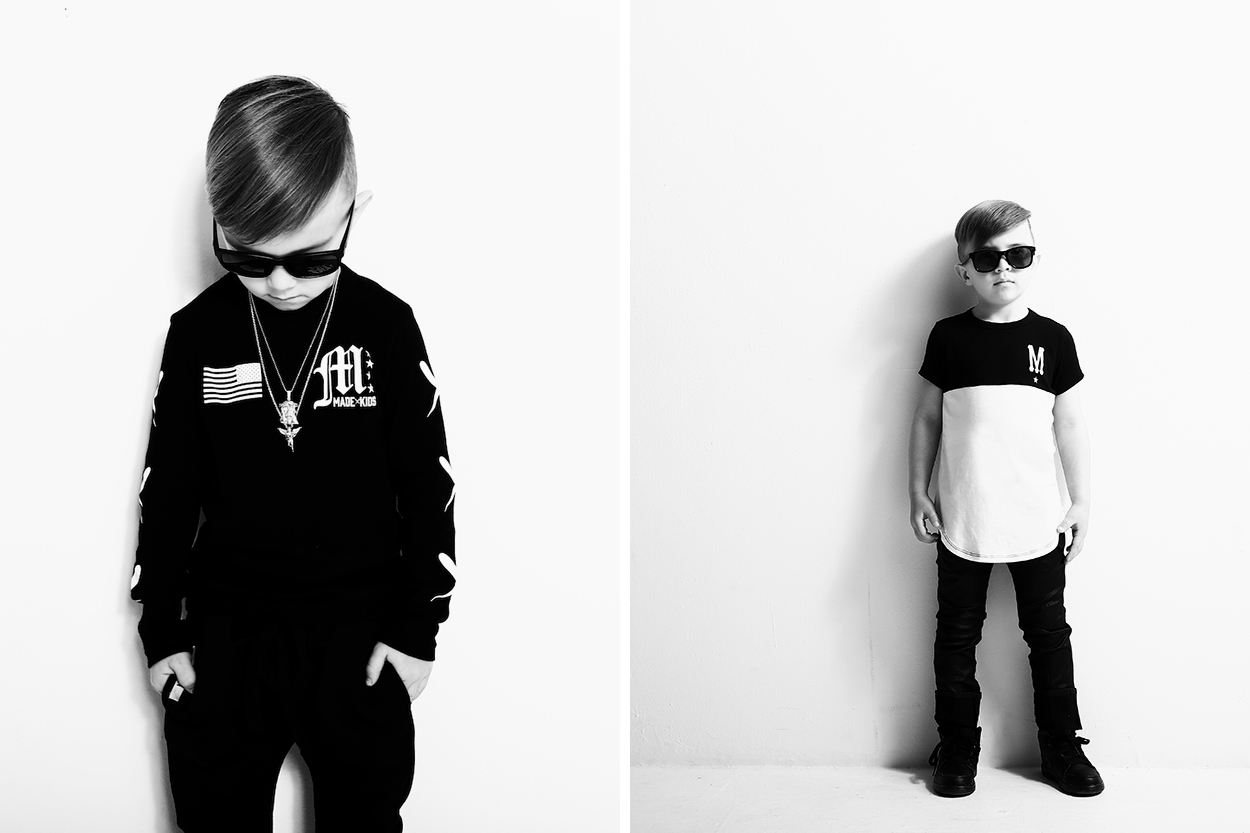
Have you guys thought about licensing at all?
Pedro: Yeah, we’re actually working on a licensing collection right now that’s going to be out for Christmas. Which is a Monopoly x MADE Kids collaboration.
When you mention Monopoly, the first thing I think about is money. What are your plans with that collection? It seems like money shouldn’t really be a priority for kids.
Pedro: We just had a meeting this morning about that collection that we’re doing and a lot of the statements and the things that we came up with, some of them we felt like, “Is this too much for a kid?” But the way that we’re approaching it, it’s not that money’s important, it’s more about having a successful mindset.
I don’t want to make it about the money. Honestly, I hate to make anything about money and put that importance on it where it rules your life. So I think we’re approaching the Monopoly collab more as an inspiration for kids. Where they can become what they want to become.
I HATE TO MAKE ANYTHING ABOUT MONEY AND PUT THAT IMPORTANCE ON IT WHERE IT RULES YOUR LIFE
Andrew: Most Monopoly collaborations are all about money. Money this, make it rain on them, money, power, everything. But the way that we’re doing it – again it falls back to our main theme throughout the whole line – [is] with a little bit more of an inspirational angle. These statements create dialogue between the parents and child.
If I get a shirt that reads, “It was all a dream,” and the kid is rocking it, the parent will be like, “Oh my god. Hey son, sit down please, you know that you can do whatever you want in this world. At the end of the day, nothing can stop you.” That’s the whole point. I guess with the Monopoly thing, we kind of want to have the same elegance to that. At the end of the day, who really inspires kids? The parents, their environment, it’s not a T-shirt.
Pedro: That whole Monopoly thing is funny because we had that talk this morning and it went from being a whole collection of statements to bringing it down to one statement and making it more kid-friendly and fun. Breaking down the Monopoly guy, little details here and there. We definitely don’t want it to clash where we’re saying, “Oh, it’s all about the money.”
It’s a sensitive topic.
Pedro: Every song you listen to is about money. On TV it’s all about money, the cool kids are the ones with money. Which sucks. You might have inspired me to make a new design for this Monopoly thing that says, “It’s not about the money.” Like, for real, you could just flip it. When you think of Monopoly, you think of money, but we can flip it so it’s not about the money.
Do not pass go.
Pedro: That’s dope. [Laughs] I like stuff like that because it makes people think and there’s a story behind that. I really like that one actually.
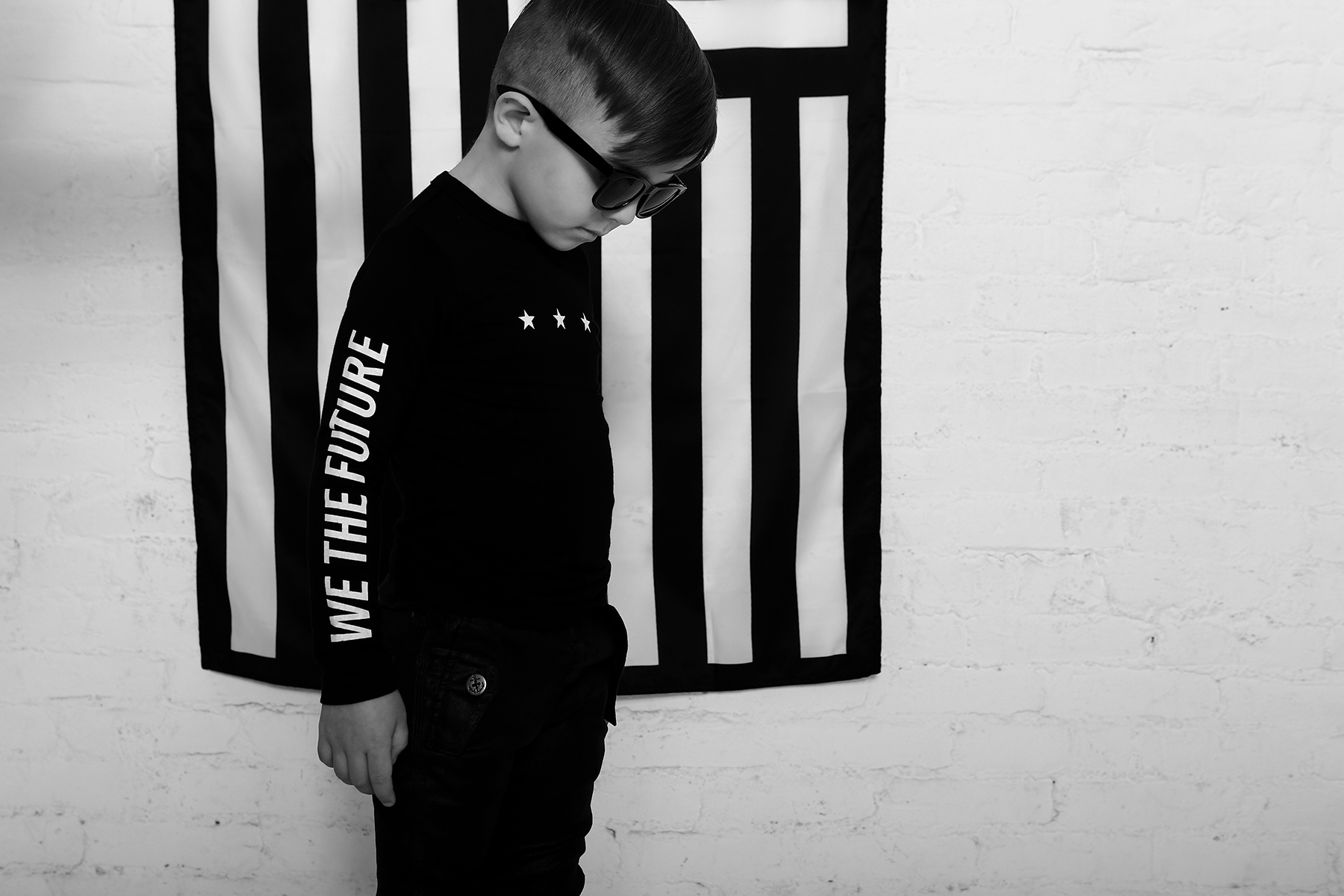
Louie: I just think more than anything, rap music is raising our kids right now, I’m just going to put that out there right now.
Is that good or bad?
Louie: It’s bad. It’s bad but it’s happening. I think right now, rap and fashion are just hand in hand. Therefore that’s why I feel like this would be a good move in a lot of ways. It’s for that rapper parent, and even if they’re not a rapper, it’s mostly the parents that are our age basically and we grew up to cool sayings like, “If I ruled the world.” And really good rap songs with inspirational names you could say.
Do you guys want to be the next Osh Kosh?
Pedro: If we could just be half that size.
Andrew: It’s hard because we’re not kids so it’s not like, “Oh, this is who we are.” But we do like to inspire and we’ve had our ups and downs but we’ve overcome them. That’s what we want to relate with our messages as well.
Louie: I think that comes through in our editorials and photo shoots, which is really cool. You don’t see the kids looking all dead serious – they might be here and there, but you see children laughing. The video of them rolling a toy truck through New York, it’s still a toy. So keeping that focus is super cool and important. Look fly but don’t grow up too fast. Still drive the Tonka truck around New York and have everyone look at you.
Pedro: I think that’s something we have to work on a little bit more because our line does look like grown up. We don’t want to get that message across, it’s not grow up too fast, it’s to have fun as a kid.
Andrew: And look damn good doing it.
::
The MADE Kids Fall/Winter 2014 Collection is now available through Madekids.com.
Follow the latest from MADE Kids on Instagram (HERE).

